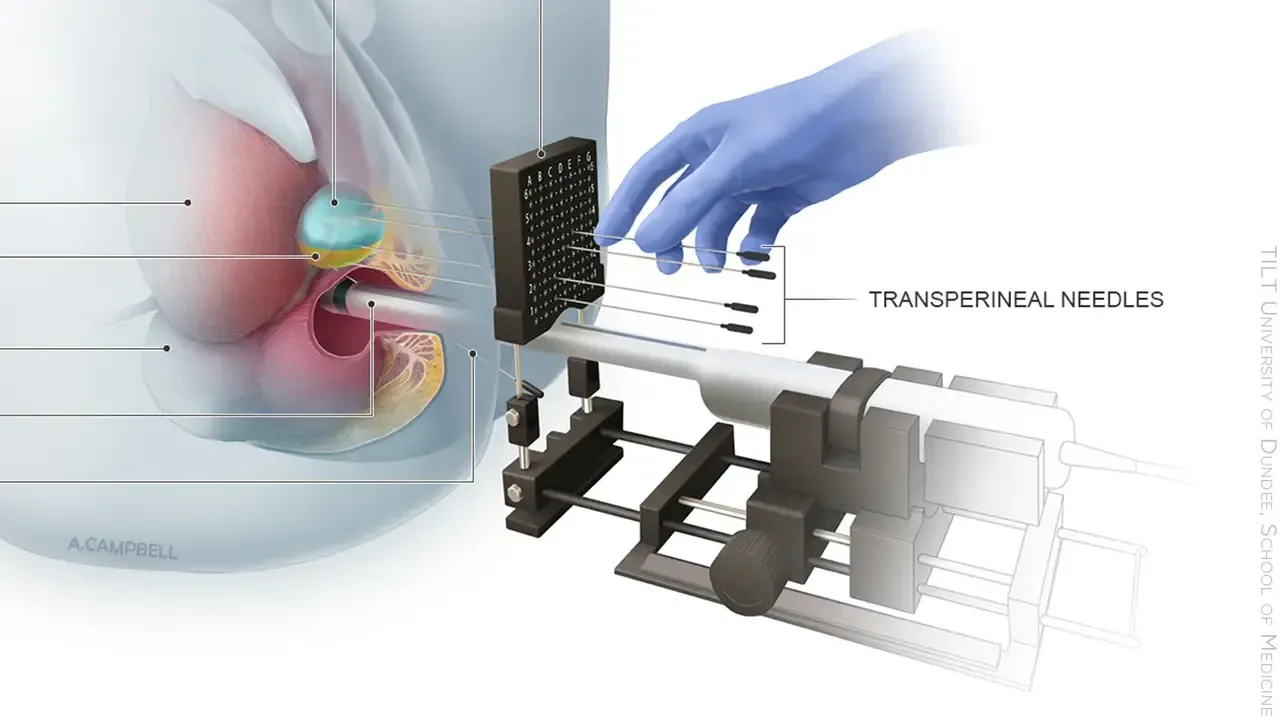Prostate Biopsy
What is a Prostate Biopsy?
A prostate biopsy is a medical procedure used to diagnose prostate cancer. It involves the removal of small samples of tissue from the prostate gland to be examined under a microscope for the presence of cancer cells.

Why Is a Prostate Biopsy Performed?
- Abnormal Test Results: A prostate biopsy is often recommended if other tests, such as a digital rectal exam (DRE), MRI imaging or a prostate-specific antigen (PSA) blood test, suggest the presence of prostate cancer.
- Elevated PSA Levels: A high PSA level can indicate various prostate issues, including prostate cancer, but it does not confirm cancer on its own. A biopsy is needed to confirm the diagnosis.
- Abnormalities on Imaging Tests: If imaging tests, such as magnetic resonance imaging (MRI), reveal suspicious areas in the prostate, a biopsy may be recommended to investigate these areas further.
- Monitoring: In some cases, a biopsy may be performed to monitor the progression of prostate cancer in men who have already been diagnosed with the disease.
Who is Suitable for Prostate Biopsy?
Not all men with an enlarged prostate will require a biopsy. Suitable candidates for a prostate biopsy for an enlarged prostate may include:
- High PSA Levels: If PSA levels are significantly elevated or continue to rise over time, particularly in men with an enlarged prostate, a biopsy may be recommended to evaluate for the presence of prostate cancer.
- Abnormal Imaging Findings: If imaging tests, such as a transrectal ultrasound (TRUS) or magnetic resonance imaging (MRI), reveal suspicious areas within the enlarged prostate, a biopsy may be performed to investigate these areas further.
- Risk Factors for Prostate Cancer: Men with risk factors for prostate cancer, such as a family history of the disease or African ancestry, may be considered for a biopsy if there are concerns about the possibility of cancer contributing to any prostate symptoms.
- Unexplained Symptoms: If a man with an enlarged prostate experiences unexplained symptoms such as pain, blood in the urine, or recurrent urinary tract infections, a biopsy may be recommended to investigate the underlying cause of these symptoms in conjunction with other tests.
Benefits of Prostate Biopsy
- Diagnosis of Prostate Cancer: Detecting prostate cancer during investigations for BPH will change the treatment approaches that will be discussed with you so that both the BPH and cancer will be treated effectively.
- Identification of Other Conditions: A biopsy can help identify other conditions that may be contributing to the enlargement of the prostate, such as prostatitis (inflammation of the prostate) or rare prostate tumours.
- Guidance for Treatment Decisions: If cancer is detected, a biopsy can provide valuable information about the aggressiveness and extent of the cancer, which can help guide treatment decisions. This may include determining the need for active surveillance, surgery, radiation therapy, or other treatments.
- Patient Reassurance: For men experiencing symptoms of an enlarged prostate, undergoing a biopsy and receiving a definitive diagnosis may provide reassurance and peace of mind, especially if cancer is ruled out.
Types of Prostate Biopsy
The primary method of diagnosing prostate cancer is through a transperineal biopsy. The biopsy needle is inserted through the skin between the scrotum and anus (perineum) to collect tissue samples from the prostate gland. If a biopsy is deemed necessary, it may be conducted using one of the following methods:
- Standard template Biopsy: In this approach, the biopsy needle is inserted in standardised zones of the prostate to sample all areas of the gland systematically. This is commonly used when there is no lesion on imaging to target.
- Fusion Biopsy is where images of an MRI are “fused” onto a real-time ultrasound to allow highly accurate targeting of suspicious areas within a prostate.
- MRI-guided biopsy: This is a targeting technique whereby the biopsy is performed in an MRI machine to accurately sample suspicious areas in a highly targeted manner. This method may be used if a fusion biopsy might not accurately sample the area of concern on a prostate MRI.
Preparation Before a Prostate Biopsy
- Medical Evaluation: Your doctor will conduct a thorough medical evaluation to assess your overall health, including any medications you are taking and any underlying medical conditions you have.
- Discussion of Risks and Benefits: Your doctor will explain the risks and benefits of the biopsy procedure, including the possibility of complications such as bleeding, infection, or discomfort.
- Medication Review: In the days before the biopsy, you may be asked to stop taking certain medications, particularly blood thinners, to reduce the risk of bleeding. However, you should only stop medicines under the guidance of your doctor.
- Antibiotics: Your doctor may prescribe antibiotics to reduce the risk of infection associated with the biopsy. It's essential to take the antibiotics exactly as prescribed.
- Hygiene Preparation: You may be instructed to take a laxative or an enema before the biopsy to empty your bowels and reduce the risk of infection.
- Arrangements: Make arrangements for transportation to and from the medical facility, as you cannot drive immediately after the procedure when sedation or general anaesthesia is used.
Prostate Biopsy Procedure
- Anaesthesia: The biopsy is typically performed under general anaesthesia or sedation, lasting approximately 20 minutes
- Biopsy Procedure: The doctor will insert a thin needle through the perineum (the skin between the scrotum and anus) to collect small tissue samples from the prostate gland. Multiple samples may be taken from different areas of the prostate to increase the accuracy of the biopsy.
- Ultrasound Guidance: During the biopsy, transrectal ultrasound (TRUS) is used to visualise the prostate gland and guide the placement of the biopsy needle.
What to Expect After a Prostate Biopsy?
- Recovery: After the biopsy, you will be monitored for a short time to ensure there are no immediate complications. You may be able to go home shortly after the procedure.
- Instructions: Your doctor will provide instructions on how to care for yourself after the biopsy, including any restrictions on activities, such as heavy lifting or strenuous exercise.
- Pain Management: After the biopsy, you may experience mild discomfort, bleeding, or blood in the urine or semen. Your doctor may prescribe pain medication or recommend over-the-counter pain relievers to manage discomfort.
- Lower urinary tract symptoms: Some men note a restriction of urinary flow after this procedure for several days or even an inability to pass any urine at all. Your urologist may discuss the need for temporary prostate medication to minimise this risk on a case-by-case basis.
- Follow-up Appointment: You will be scheduled for a follow-up appointment with your doctor to discuss the biopsy results and any further treatment or monitoring that may be required.
- Monitoring for Complications: While complications after a prostate biopsy are rare, it's essential to monitor for signs of infection, such as fever, chills, or persistent pain or swelling in the perineal area. If you experience any concerning symptoms, contact your doctor immediately.
Prostate Biopsy Risks and Complications
While a prostate biopsy is generally considered safe, there are some risks and complications to be aware of, including:
- Bleeding: Some bleeding in the urine or semen is common after the procedure. This is usually mild and settles after a few days.
- Infection: After a biopsy, there is a risk of developing a urinary tract or prostate infection. Antibiotics given at the procedure minimise this risk.
- Difficulty Urinating: For a short time after the biopsy, you may experience difficulty urinating. Medications are available to minimise this risk and will be discussed with you before the procedure.
- Rare Complications: Although rare, more serious complications such as urinary retention, significant bleeding, or sepsis (a life-threatening infection) can occur.







